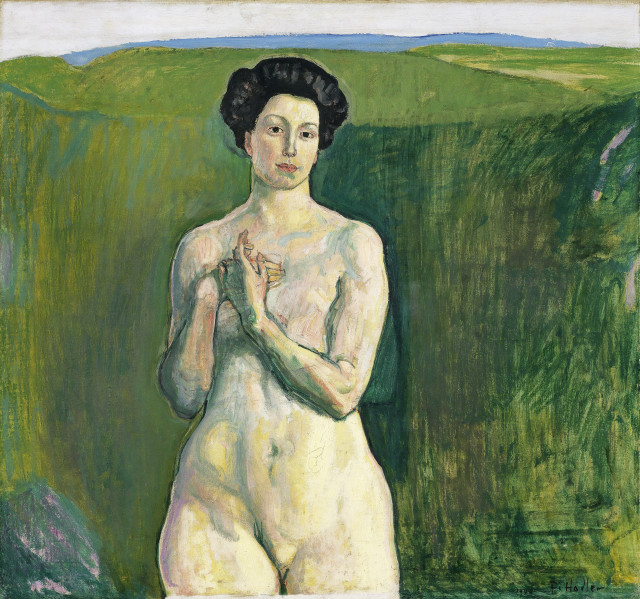- FR
S’inscrire
- Acheter
- Vendre
- Plus
- Galerie
- Commerce d'art
- Maison d'Édition
- Kornfeld aujourd’hui
- L'histoire de la Maison
- Informations


Bern 1853 - 1918 Genf
Um 1904
Oil on canvas
71,5x76,5 cm
Lower right dated and signed by the artist "1900 F. Hodler"
Oskar Bätschmann und Paul Müller, Ferdinand Hodler, Catalogue raisonné der Gemälde, volume 3, Die Figurenbilder, sb-volume 1, no. 1346
Galerie Moos, Geneva (1921)
Auction Galerie Moos, Geneva, 20 March 1937, cat. no. 86, ill.
Private collection, USA (1973)
Changing private ownership, from there to
Private collection, Switzerland (2006), by descent to
Private collection, Switzerland
Loosli 1921-1924, Generalkatalog, cat. no. 1481
Jura Brüschweiler, Eine unbekannte Hodler-Sammlung aus Sarajewo, exhibiton catalogue Kunstmuseum Bern, Bern 1978, Benteli, p. 12-13
Geneva 1918, Galerie Moos, Ferdinand Hodler, cat. no. 72, verso the stamp
Basel 1919, Kunsthalle, Gedächtnisausstellung Ferdinand Hodler, cat. no. 49
Bern 1921, Kunstmuseum, Hodler-Gedächtnis-Ausstellung, cat. no. 316, label on verso
Dresden 1925, Galerie Ernst Arnold, Mai-Ausstellung. Ferdinand Hodler, Ernst Ludwig Kirchner, Fritz Huf, cat. no. 18
Exposition Ferdinand Hodler, exh. cat. Galerie (??)
Geneva 1928, Galerie Moos, Ferdinand Hodler, cat. no. 32
Geneva 1936, Galerie Moos, Exposition organisée à l'occasion du XIVe Congrès international d'Histoire de l'Art, cat. no. 36
Original stretcher, mostly original nailing. Verso with water stains. Isolated craquelure, fresh colours, in very good overall condition
The painting comes from the group of works "Weib am Bach" / "Die Quelle" (Bätschmann / Müller). In contrast to the other works in the series, Hodler chose a three-quarter view and thus directs the gaze to the beautifully crafted face and the crossed hands. The work thus occupies a middle position between portrait and figure image. The woman seems to be standing in the room in front of the reduced background, framed by the gently suggested hills and the horizon. In the three variants of "Die Quelle", Hodler takes up the pictorial tradition of allegorical source representations, but has completely omitted the source or the brook and anecdotal accessories. With this he achieves an amazing focus on women as life givers themselves. The crossed hands and the direct view of the viewer can be read as a gesture of feeling and emotion. Due to the year added by Hodler, the painting was dated to 1900 until it was corrected by Jura Brüschweiler, which is excluded, however, since the artist depicted this Model Jeanne Charles first met in autumn 1901. At the very bottom, partially covered by the frame, it can be seen that Hodler, probably expanded the painting by a few centimeters before the first exhibition, the canvas is not completely turned over below either. A very haunting painting
Um 1904
Öl auf Leinwand
71,5x76,5 cm
Unten rechts vom Künstler in Pinsel in Öl datiert und signiert "1900 F. Hodler"
Oskar Bätschmann und Paul Müller, Ferdinand Hodler, Catalogue raisonné der Gemälde, Band 3, Die Figurenbilder, Teilband 1, Zürich 2012,
Galerie Moos, Genf (1921)
Auktion Galerie Moos, Genf, 20.3.1937,
Privatsammlung USA, (1973)
Wechselnder Privatbesitz, von dort an
Privatsammlung Schweiz (2006), durch Erbschaft an
Privatsammlung Schweiz
Loosli 1921-1924, Generalkatalog,
Jura Brüschweiler, Eine unbekannte Hodler-Sammlung aus Sarajewo, Ausstellungskatalog Kunstmuseum Bern, Bern, Benteli, 1978, pag. 12-13
Genf 1918, Galerie Moos, Ferdinand Hodler,
Basel 1919, Kunsthalle, Gedächtnisausstellung Ferdinand Hodler,
Bern 1921, Kunstmuseum, Hodler-Gedächtnis-Ausstellung,
Dresden 1925, Galerie Ernst Arnold, Mai-Ausstellung. Ferdinand Hodler, Ernst Ludwig Kirchner, Fritz Huf,
Genf 1928, Galerie Moos, Ferdinand Hodler,
Genf 1936, Galerie Moos, Exposition organisée à l'occasion du XIVe Congrès international d'Histoire de l'Art,
Auf dem originalen Chassis, grossteils in der originalen Nagelung. Rückseitig mit Wasserflecken. Vereinzelte Craquelüren, farbfrisch und in sehr guter Gesamterhaltung
Das Gemälde stammt aus der Werkgruppe "Weib am Bach" / "Die Quelle" (Bätschmann/Brunner/Walter). Im Gegensatz zu den anderen Arbeiten der Serie wählte Hodler eine Dreiviertel-Ansicht und lenkt den Blick damit auf das sehr schön ausgearbeitete Gesicht und die gekreuzten Hände. Das Werk nimmt damit eine Mittelposition ein zwischen Porträt und Figurenbild. Die Frau scheint vor dem reduziert gehaltenen Hintergrund sphärisch im Raum zu stehen, eingefasst von den zart angedeuteten Hügeln und dem Horizont. Bei den drei Varianten von "Die Quelle" nimmt Hodler die Bildtradition allegorischer Quellendarstellungen auf, hat aber die Quelle oder den Bach sowie anekdotisches Beiwerk gänzlich weggelassen. Er erreicht damit eine verblüffende Fokussierung auf die Frau als Lebensspenderin an sich. Die gekreuzten Hände und der direkte Blick zum Betrachter können als Gestus der Empfindung und Ergriffenheit gelesen werden
Aufgrund der von Hodler nachträglich angebrachten Jahreszahl wurde das Gemälde bis zur Korrektur durch Jura Brüschweiler ins Jahr 1900 datiert, was jedoch ausgeschlossen ist, da der Künstler das dargestellte Modell Jeanne Charles erst im Herbst 1901 kennenlernte. Ganz unten, teilweise vom Rahmen verdeckt, ist zu erkennen, dass Hodler, das Gemälde wohl vor der ersten Ausstellung um einige Zentimeter erweiterte, die Leinwand ist unten auch nicht komplett umgeschlagen. Ein sehr eindringliches Gemälde



